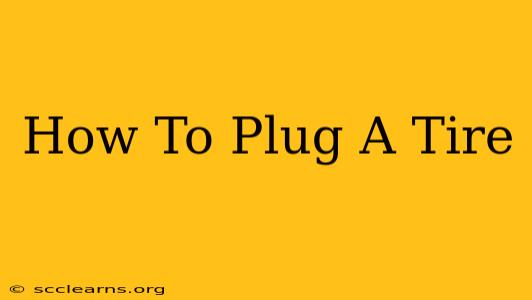A flat tire is a frustrating experience, but knowing how to plug a tire can save you time and money. This guide provides a comprehensive, step-by-step approach to safely and effectively plugging your tire. Remember: Plugging a tire is a temporary fix; it's crucial to get your tire professionally repaired or replaced as soon as possible.
Assessing the Damage: Before You Begin
Before you even think about grabbing your tire plug kit, carefully inspect the puncture.
- Location: Is the puncture in the sidewall of the tire? If so, do NOT attempt to plug it. Sidewall punctures compromise the structural integrity of the tire and require professional replacement. Plugging a sidewall puncture is extremely dangerous.
- Size: A small puncture is much easier to repair than a large gash or multiple punctures. If the damage is extensive, professional repair or replacement is necessary.
- Foreign Object: Remove any remaining object (nail, screw, etc.) causing the puncture. This will be much easier before you begin the plugging process.
Gathering Your Supplies: What You'll Need
You'll need a few essential tools to successfully plug your tire:
- Tire Plug Kit: This typically includes plugs, a reamer, and a lubricant.
- Tire Pressure Gauge: To check the tire pressure after the repair.
- Gloves: To keep your hands clean.
- Jack and Lug Wrench: To safely lift and secure your vehicle.
- Wheel Chocks (optional but recommended): For extra safety.
Step-by-Step Guide to Plugging a Tire
1. Preparation is Key:
- Safety First: Park on a level, stable surface, engage the parking brake, and use wheel chocks on the wheels opposite the flat. This prevents accidental rolling.
- Loosen Lug Nuts: Before jacking up the vehicle, slightly loosen the lug nuts on the flat tire. This is easier to do while the tire is still on the ground.
- Jack Up the Vehicle: Carefully jack up the vehicle until the flat tire is off the ground. Consult your vehicle's owner's manual for the correct jacking points.
- Remove the Wheel: Once the tire is off the ground, completely remove the lug nuts and carefully remove the flat tire.
2. Preparing the Puncture:
- Clean the Hole: Use a wire brush or similar tool to thoroughly clean the puncture area, removing any debris.
- Reaming the Hole: Use the reamer tool (included in your kit) to carefully enlarge the puncture hole. This creates a slightly tapered hole that will provide a better grip for the plug. Don't over-ream!
3. Inserting the Plug:
- Lubricate the Plug: Apply a small amount of lubricant (provided in your kit) to the tire plug. This helps it slide into the hole more easily.
- Insert the Plug: Carefully insert the plug into the reamed hole, pushing it all the way through until the barbed ends are visible on the inside of the tire.
- Trim Excess Plug: Once the plug is fully inserted, carefully trim off any excess material that extends beyond the tire's surface using scissors or a sharp knife.
4. Reassembly and Inflation:
- Replace the Wheel: Carefully replace the wheel onto the vehicle's hub.
- Tighten the Lug Nuts: Tighten the lug nuts in a star pattern (opposite nuts first, then the ones in between) to ensure even pressure. Do not fully tighten them yet.
- Lower the Vehicle: Carefully lower the vehicle to the ground.
- Fully Tighten Lug Nuts: Once the vehicle is on the ground, fully tighten the lug nuts using a lug wrench.
- Inflate the Tire: Inflate the tire to the recommended pressure (check the sticker on your driver's side doorjamb or your owner's manual).
5. Post-Repair Check:
- Check for Leaks: Carefully examine the plugged area for any signs of leakage.
- Drive Carefully: Drive carefully for a short distance to ensure the repair holds.
- Professional Repair: Remember, this is a temporary repair. Take your tire to a professional for a permanent repair as soon as possible.
Important Considerations
- Tire Condition: If your tire is old, worn, or has other damage, plugging it might not be the best solution. Professional assessment is advised.
- Location of Puncture: Plugging a tire near the sidewall is extremely dangerous and should be avoided.
- Safety First: Always prioritize safety when working with your vehicle.
By following these steps and exercising caution, you can successfully plug a tire and get back on the road. However, remember that this is a temporary fix. Always get your tire professionally repaired or replaced for long-term safety and reliability.

